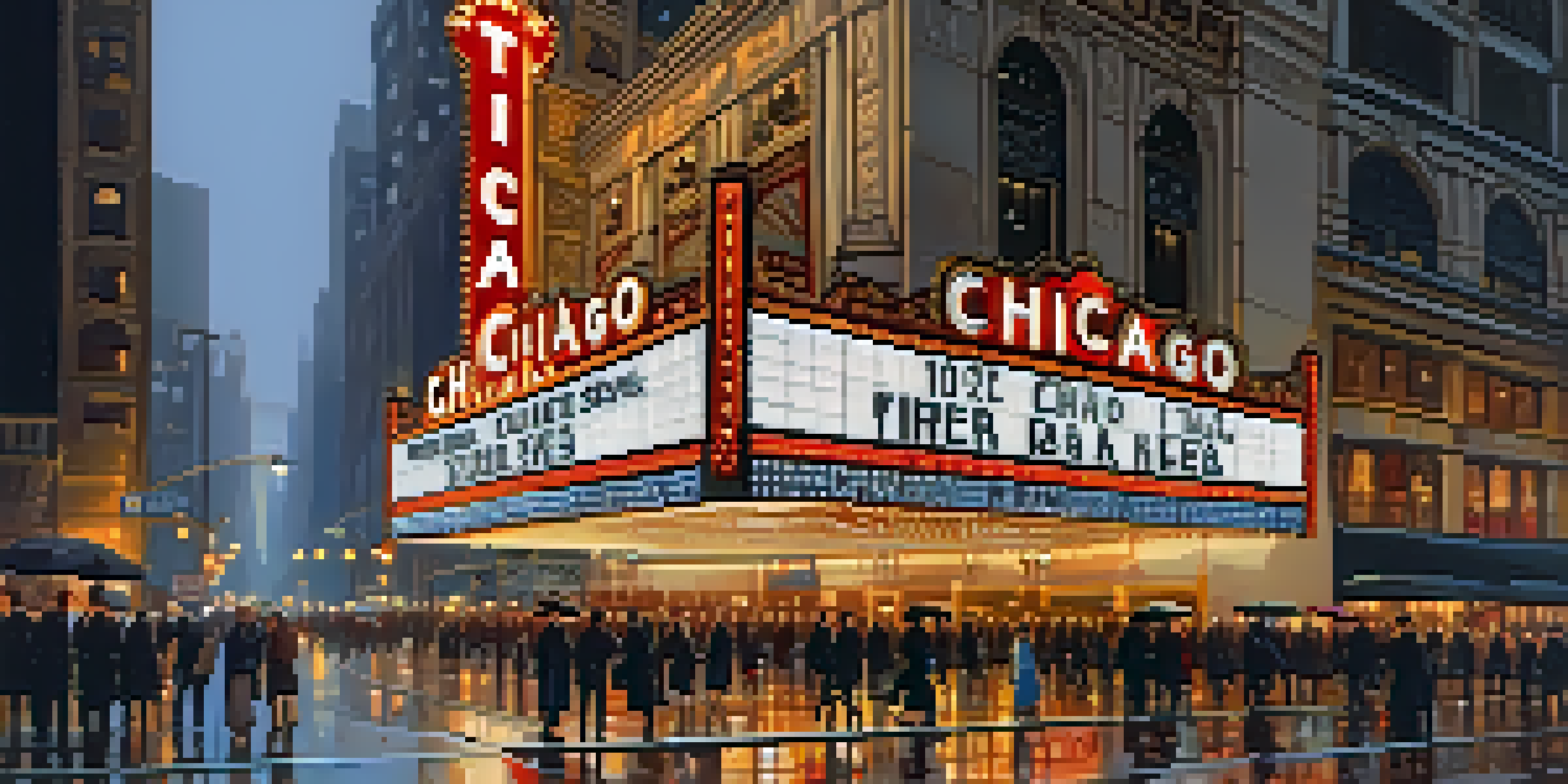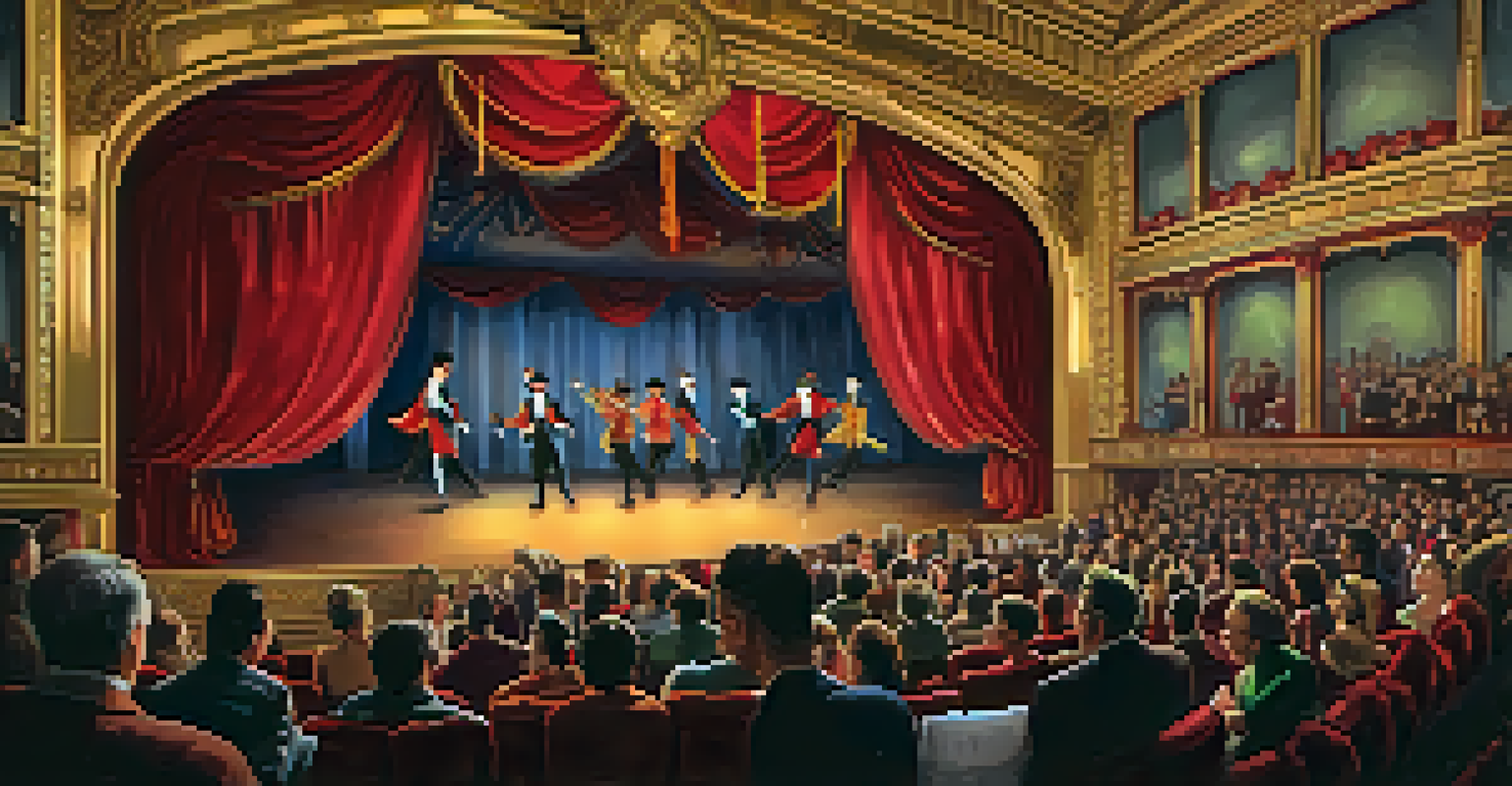Exploring the Rich History of Chicago's Legendary Theaters

The Birth of Chicago's Theatrical Scene
Chicago's theater scene has roots tracing back to the mid-19th century, when traveling troupes began performing in makeshift venues. The city's rich cultural tapestry laid the groundwork for a vibrant arts community that welcomed diverse performances. As the population grew, so did the demand for entertainment, leading to the establishment of dedicated theaters that would become iconic.
The theater is a great source of entertainment and a means of education for the people. It can influence the culture and the behavior of society.
One of the first significant theaters was the Academy of Music, which opened in 1855 and showcased everything from opera to melodrama. This venue not only entertained but also set the stage for Chicago as a cultural hub. The city quickly became known for its theatrical innovations, attracting talent and audiences alike.
By the late 1800s, Chicago was home to a variety of theaters, including the famous Haymarket Theatre, which embraced both avant-garde and classic performances. This eclectic mix laid the foundation for the rich and diverse theatrical history that Chicago would continue to develop.
The Golden Age of Vaudeville
In the early 20th century, vaudeville took Chicago by storm, bringing a new wave of entertainment that combined comedy, music, and variety acts. The Orpheum Theatre, among others, became a hotspot for both local and national talent, showcasing the likes of comedians, musicians, and dancers. This era was significant in shaping the city's identity as a center for diverse and engaging performances.

Vaudeville theaters were not just places to perform; they were community gathering spots where audiences could enjoy a night out. Families would flock to these venues, drawn by the promise of laughter and amazement. As vaudeville evolved, many theaters began to host films, blending the worlds of live performance and cinema.
Chicago's Theatrical Evolution
Chicago's theater scene has transformed from traveling troupes in the 19th century to a vibrant mix of local and Broadway productions.
The decline of vaudeville in the 1930s marked a turning point for Chicago's theaters, prompting many to adapt and reinvent themselves. While some struggled to survive, others embraced the changing landscape, paving the way for new forms of entertainment that would captivate audiences for generations.
Architectural Marvels of Chicago Theaters
One cannot discuss Chicago's theatrical history without mentioning its stunning architecture. The city's theaters, from the ornate Chicago Theatre to the majestic Auditorium Theatre, are not just venues; they are masterpieces that tell stories of their own. These buildings were designed to impress, featuring intricate details that reflect the grandeur of the performing arts.
Art is not a mirror held up to reality, but a hammer with which to shape it.
The Chicago Theatre, often called the 'Magnificent One,' opened its doors in 1921 and became an instant landmark. Its dazzling marquee and lavish interior are a testament to the opulence of the era. Such architectural gems not only enhance the viewing experience but also serve as historical touchstones for the community.
As the years passed, many theaters faced challenges related to preservation and modernization. Fortunately, a renewed interest in historic restoration has helped many of these iconic venues retain their charm while adapting to contemporary needs, ensuring that future generations can appreciate their beauty.
The Rise of Broadway in Chicago
Chicago has long been a vital stop for Broadway shows, offering audiences a taste of New York's theatrical magic. The city's theaters, such as the Bank of America Theatre and the Cadillac Palace Theatre, frequently host national tours of popular productions. This trend has solidified Chicago's reputation as a major player in the theatrical landscape.
The Windy City is often seen as a testing ground for new works before they hit Broadway, making it an exciting destination for theater enthusiasts. Many productions have found success in Chicago, paving the way for their eventual Broadway debuts. This symbiotic relationship between Chicago and Broadway enriches the cultural fabric of the city.
Community Theaters' Impact
Smaller community and ensemble theaters in Chicago play a crucial role in fostering local talent and addressing social issues.
By embracing both local talent and Broadway hits, Chicago's theaters cultivate a dynamic environment where creativity thrives. Audiences are treated to a diverse array of performances that reflect the city's artistic spirit, ensuring that there is something for everyone to enjoy.
The Impact of Community and Ensemble Theater
Beyond the grand venues, Chicago is home to a thriving community and ensemble theater scene. Smaller theaters, such as Steppenwolf and Goodman Theatre, have made significant contributions to the city's cultural identity. These organizations prioritize collaboration and innovation, often presenting thought-provoking works that resonate with local audiences.
Community theaters play a vital role in fostering artistic expression and providing a platform for emerging talent. They often tackle pressing social issues, engaging audiences in meaningful conversations. This grassroots approach to theater encourages a sense of belonging and ownership within the community.
Through their dedication to local narratives and diverse voices, ensemble theaters enrich the overall theatrical landscape of Chicago. They remind us that theater can be both a powerful art form and a catalyst for change, inspiring individuals and communities alike.
Challenges Faced by Chicago Theaters
Like many cities, Chicago's theaters have faced a myriad of challenges over the years, from economic downturns to the impact of the COVID-19 pandemic. Many venues struggled to stay afloat during closures, highlighting the fragility of the arts. The pandemic forced theaters to rethink their approach, leading to a surge in virtual performances and innovative programming.
Despite these obstacles, the resilience of Chicago's theater community is truly inspiring. Collaborations emerged, allowing theaters to pool resources and support each other during tough times. This sense of solidarity has not only strengthened the community but also showcased the importance of the arts in our lives.
Resilience Amid Challenges
Despite facing economic hardships and the pandemic, Chicago's theaters have shown remarkable resilience and adaptability.
As theaters begin to reopen, there's a renewed sense of hope and determination. Audiences are eager to return, and theaters are finding creative ways to engage with their communities. This challenging period has underscored the essential role that live performance plays in bringing people together.
The Future of Theater in Chicago
Looking ahead, the future of theater in Chicago is filled with promise and potential. With a rich history as its foundation, the city is poised to continue evolving as a theatrical hub. As new generations of playwrights, directors, and performers emerge, they bring fresh perspectives that will shape the next chapter of Chicago's artistic narrative.
The integration of technology and innovative storytelling methods is transforming the way audiences experience theater. From immersive performances to interactive elements, Chicago's theaters are embracing change while honoring their roots. This blend of tradition and innovation ensures that the city remains at the forefront of the theatrical landscape.

Ultimately, the future of Chicago's theaters lies in their ability to adapt and connect with audiences. By fostering inclusivity and celebrating diverse voices, these venues can continue to thrive and inspire, ensuring that the magic of theater endures for generations to come.